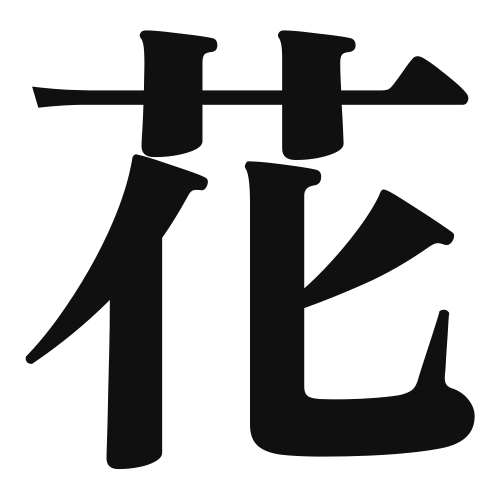1. Overview of Meaning
The kanji “花” (hana) means “flower” in Japanese. It represents the beauty and delicacy of blooming plants, often symbolizing nature, growth, and the transient nature of life.
2. Formation and Radical
Formation of the Kanji: The kanji “花” is a phonetic-ideographic character (形声文字). It combines the radical for “plant” (艹) at the top, indicating its relation to flora, with the phonetic component “華” (ka), which contributes to its pronunciation.
Radical: The radical for “花” is 艹 (grass), which is commonly found in kanji related to plants and vegetation.
3. Examples of Usage
Common Words and Phrases:
- 花火 (hanabi) – fireworks
- 花束 (hanataba) – bouquet
- 花見 (hanami) – cherry blossom viewing
Example Sentences in Daily Conversation:
- 春には桜の花が咲きます。 (Haru ni wa sakura no hana ga sakimasu.) – In spring, cherry blossoms bloom.
- 彼女に花束を贈りました。 (Kanojo ni hanataba o okurimashita.) – I gave her a bouquet of flowers.
4. Synonyms and Antonyms
Similar Kanji:
- 華 (ka) – This kanji also relates to flowers but often emphasizes beauty and elegance.
- 草 (kusa) – This means “grass” and refers to a different type of plant, focusing more on the ground cover rather than flowering plants.
Antonyms:
- 枯れ (kare) – This means “withered” or “dried up,” representing the opposite of blooming and vitality.
5. Cultural and Historical Background
Connection to Japanese Culture: Flowers hold significant cultural importance in Japan, symbolizing the beauty of nature and the fleeting nature of life, as seen in the tradition of hanami (flower viewing) during cherry blossom season.
Proverbs and Idioms:
- 花より団子 (Hana yori dango) – This proverb means “dumplings over flowers,” suggesting that practical needs are more important than aesthetic pleasures.
- 花が咲く (Hana ga saku) – This phrase means “to bloom,” often used metaphorically to describe someone achieving success or happiness.
